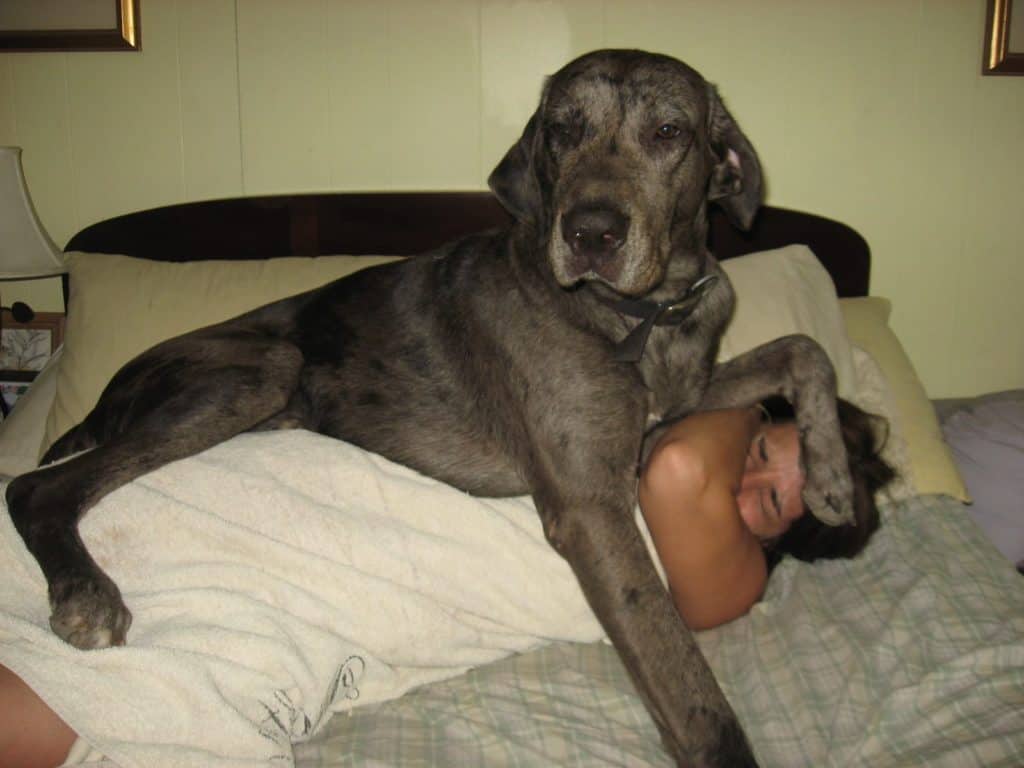
A mixed-breed designer dog from the Yorkie and Daschund, the Dorkie – also known as the Doxie Terrier and Dorkie Terrier – has the best traits of both breeds.
Fiercely loyal yet laid back and playful, this designer mix is perfect for active owners who go for hikes and camping trips and chilled-out people who prefer relaxing on the couch.
Dorkies fit well with single-person households where you cuddle and walk together every day. However, a Doxie could also have a good time with a family with older children – Dorkies need plenty of attention.
But how big will a Dorkie get? How much space do you need to make for them? And how much energy do they need to burn off every day? Let’s explore this:
How tall can the Dorkie get?
Though they may have occurred naturally now and then over the years, the Dorkie is a young breed, first intentionally crossed in the 1990s. Being so young means that Doxie puppies still vary considerably in size. On average, however, you can expect a Dorkie to grow to anywhere from 5 to 10 inches.
How much does the Dorkie weigh?
The Yorkie is a lapdog with low energy requirements, while the Dachshund is a more active dog with a hunting past and, thus, is usually more muscular. Once again, though, this means the jury’s out on how much a Dorkie could weigh. Anywhere from 5 to 12 pounds is fairly average for a Dorkie.
How much exercise does a Dorkie need?
Dorkies are chilled-out lapdogs and playful, energetic travel companions in equal parts. They love to go for long walks and play for hours, but be careful about allowing your Doxie to jump up or climb – it’s not good for their spine.
However, their relatively small size means that these dogs don’t require loads of exercise. So, a gentle evening stroll around the block should be fine for most Dorkies, with some play to let them work off excess energy when they need it.
Why was the Dorkie bred?
By the 1990s, many purebred dogs started to suffer from inherited health issues that crossbreeding could mitigate. For example, Yorkies were becoming more prone to seizures, while Dachshunds were getting so long and short that they had back problems and struggled to walk.
Though this problem is being resolved with careful breeding, crossing a Dachshund with a Yorkie makes it impossible for the puppies to inherit most primary health conditions.
A designer breed, today’s Doxies are sweet, playful pooches, recognized by hybrid and designer dog kennel clubs up and down the country.
How much space does the Dorkie need outside?
Though they don’t require too much exercise, a Doxie’s Dachshund half loves to dig and zoom around when they go outside. So, a Dorkie would enjoy having loads of room to run around. But this doesn’t mean you need to have a large yard to adopt a Doxie.
If your Dorkie loves having plenty of space to run around, take them to the beach or large park. Doxies can struggle with recall, so do make sure to work on this when you go there. But it will be worth it to see the look on your Dorkie’s face as they dig, spin, and sprint up and down.
What do Dorkies look like?
The Doxie is a small dog with some features and traits of the Dachshund and Yorkshire Terrier. But what can you expect your Dorkie to look like?
Doxies can have brown, red, blue, or black coats like the Yorkie. They may feature the same color all over their body but are typically a blend of two or more of these colors.
Dorkies have straight, dense fur that can be medium to long. They shed a fair bit and aren’t hypoallergenic dogs – do not adopt a Doxie if you are allergic to fur. But, again, there is still plenty of variance within this young breed – who knows what to expect?
Doxies have low-maintenance coats, too. You only really need to brush them a couple of times a week.
Their thin coats aren’t very insulating, however. So your Dorkie will need a heavy coat for those winter walks, while they’ll need sunscreen and plenty of shade in the summer – despite how much they may prefer to be in the sun!
How much room does a Dorkie need indoors?
With their small size, surely the Doxie doesn’t need too much space indoors? Yes, but there are some things you should bear in mind.
Your Doxie shouldn’t jump or climb onto their bed. This movement is harmful to their spine. Make sure your Dorkie’s bed is flat. If your Doxie likes to get on the couch, lift them up or use ramps.
Your Dorkie may like a bolster bed with space to rest their chin. This helps keep them cool and is more comfortable for them.
So, though they are a young breed and it’s hard to know what to expect, don’t worry – Dorkies don’t get too big. You may be surprised by how much energy this smaller dog has to burn up!
They are easy to care for, too, with simple grooming requirements and generally good health. Just make sure you remember to pick up a warm coat for your Doxie to wear in the winter and stock up on doggy sunscreen to use on sensitive areas in the summer.
Be prepared to give your Dorkie plenty of attention, too! They are affectionate and friendly but surprisingly delicate and easy to injure. So, always supervise your Doxie around children.
They also may exhibit some Terrier and small dog syndrome tendencies, such as barking and aggression towards other dogs. So, be sure to socialize your Dorkie thoroughly from an early age to prevent this.


